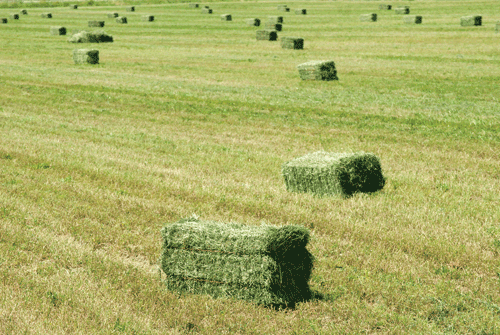
For 2012, the news was bad again for dairies and other hay buyers. Longer term, it doesn't look much better.
During the most recent conference at Las Vegas in December, Hoyt said self-preservation strategies taken by growers after the dairy industry's financial collapse in 2009 look to be a trend rather than a temporary reaction, and its effects suggest tighter hay production and supplies for at least several years to come.
This, combined with projections of continued increases in global hay demand, points to little or no chance of a return to cheap hay prices seen in previous years. Unless they want to start growing their own, Western dairy producers may have no alternative but to deal with high hay prices as best they can.
Hoyt said hay growers' defensive reaction to 2009 isn't surprising because they suffered along with the dairy industry. "Just as dairymen will never forget 2009, hay growers won't either," he pointed out.
Milk producers will also probably never forget 2011 because of the way hay prices went to the moon and are still in orbit. During his talk, Hoyt showed a graph of premium retail alfalfa hay prices in California's Imperial Valley between July 2010 and April 2011. It looked liked a jets trajectory for takeoff.
In those 10 months alone, prices rose from about $130 per ton to about $290. In Tulare, supreme prices hit $350. Prices in Idaho, Utah, and Nevada approached or passed $250.
More hay buyers now
While that sharp spike has curbed hay demand a little, dairies and other domestic buyers tend to forget that they're not the only ones who are shopping for it these days. Part of the reason why cheap hay prices went away and may never come back is because there are many international buyers to compete with.
Despite the huge price spike in 2011, hay export volume kept rising. China, which bought just 20,000 tons of West Coast hay in 2008, bought 140,000 tons in 2010 and was projected to take 160,000 tons in 2011.
One of the surprises Hoyt expects in 2012 is the number of planted alfalfa acres is likely to increase only slightly. That's a big change from the response growers have usually shown following a boom year.
"It appears that alfalfa hay acres, which historically would have been up 15 percent or more with such a strong alfalfa hay market in 2011, will be up only 2 to 5 percent in the seven Western states," he said. "Growers still have crop options, and they are concerned about many dairies that are still struggling, and as I mentioned earlier, farmers who [are able to] want to be more diversified in their farming operation."
Growers' uneasiness about the dairy industry centers around uncertainty about milk prices, profitability, and their ability to pay for hay.
"We have seen much improvement in the near- term outlook for milk prices, but there is still concern about where prices are going after January," he said. "There are still questions if the strong domestic demand for cheese in late 2011 will continue into the first half of 2012. World dairy markets have been moving higher, and that will continue. U.S. milk production reports in the coming months will also be a key factor as to where milk prices will go in the first half of 2012."
Hoyt said he expects hay exports will stay strong in 2012, with good demand coming from the United Arab Emirates, China, Japan, and Korea. Rain damage to Australia's oaten hay crop last fall should improve demand for sudan and timothy hay in the Western U.S. and may also help demand for alfalfa hay.
Strong export competition
"Exports of alfalfa hay in the West will be driven by the dairy market," he added. "Competition will be strong between export buyers, but I believe a moderation of prices is what they are hoping for. Overseas customers were not happy with the very strong prices in 2011 and are hoping prices will come down in 2012."
Hoyt made price predictions for 2012 reluctantly, due to uncertainty about market push-back against last year's prices, the recovering global economy, U.S. milk prices, and the dairy industry's financial health.
He believes prices on the first hay crop in the West in 2012 will be the strongest market of the season. "The reason is because supplies of higher quality alfalfa will be very tight coming into the 2012 new crop season," he said. "How high prices will be on first-cutting hay will depend on supplies and how high milk prices are.
"Prices on second and following cuttings in the West will decline, but not drastically, and I believe growers' average prices for the 2012 season will be down at least $30 per ton and could be as much as $50 per ton lower if alfalfa acres and production are higher than expected and milk prices are lower than expected."











